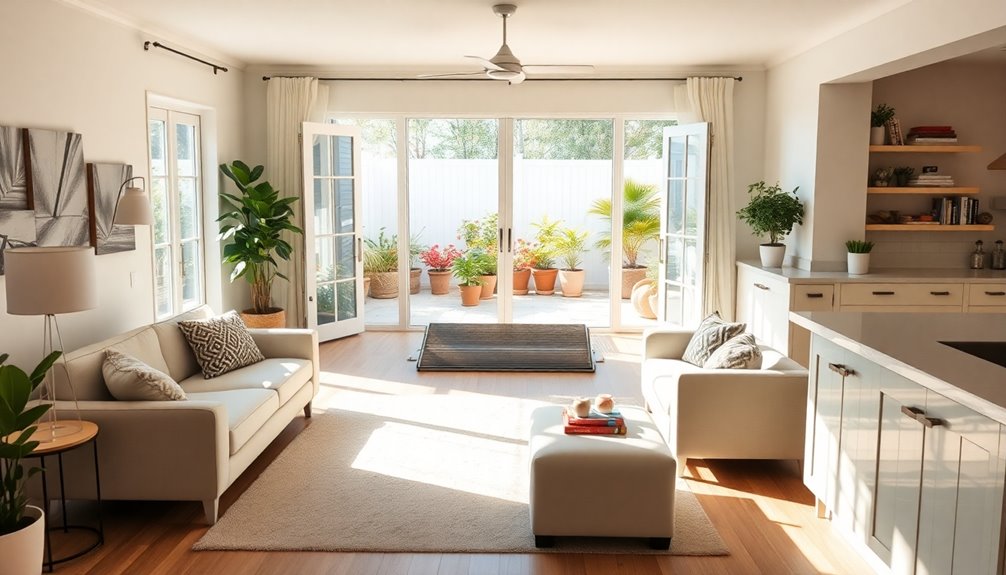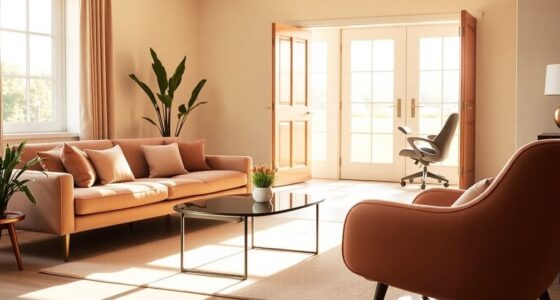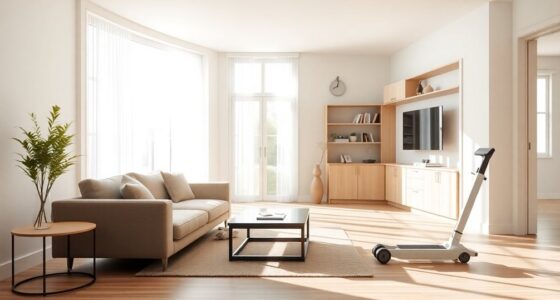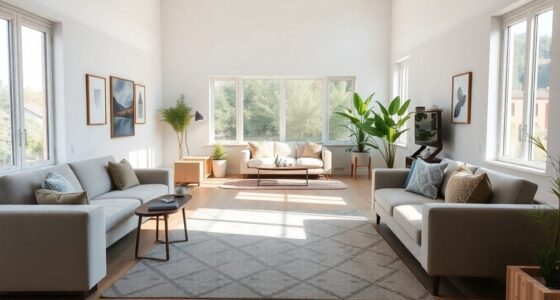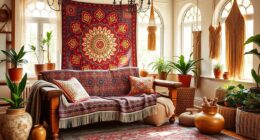Universal design makes your home stylish and accessible for everyone, no matter their age or ability. You'll love features like efficient light sensors that enhance safety and energy efficiency. Curbless showers, slip-resistant floors, and wide doorways create a welcoming atmosphere while ensuring ease of movement. A beautiful, safe bathroom with grab bars and benches adds functionality. With thoughtful design elements, your home can be both functional and inviting. Discover more ways to elevate your space!
Key Takeaways
- Universal design principles create inclusive spaces, ensuring accessibility for individuals of all ages and abilities.
- Smart home solutions like light sensors enhance safety and energy efficiency by automating lighting based on room occupancy.
- Accessible bathroom features, such as curbless showers and grab bars, promote safety and comfort during personal care routines.
- Family-friendly kitchen elements, including ergonomic faucets and anti-scald technology, make cooking and cleaning easier for everyone.
- Safety strategies like wide doorways and slip-resistant flooring reduce fall risks, enhancing overall home safety for all residents.
What Is Universal Design?

Universal design is all about creating spaces that work for everyone, regardless of age or ability. This approach enhances functionality in your home by following universal design principles, which focus on broader accessibility needs.
Unlike aging in place, universal design guarantees that your environment adapts to both current and future requirements. It promotes coexistence and independence among all individuals, from toddlers to seniors and those with disabilities.
Aesthetics matter here; you can achieve stylish, functional spaces without compromising on design. By incorporating features like wider doorways and curbless showers, you greatly improve safety and accessibility in your home.
Embracing accessibility design means every member of your household can thrive in a comfortable, welcoming environment.
Efficient, Helpful Light Sensor
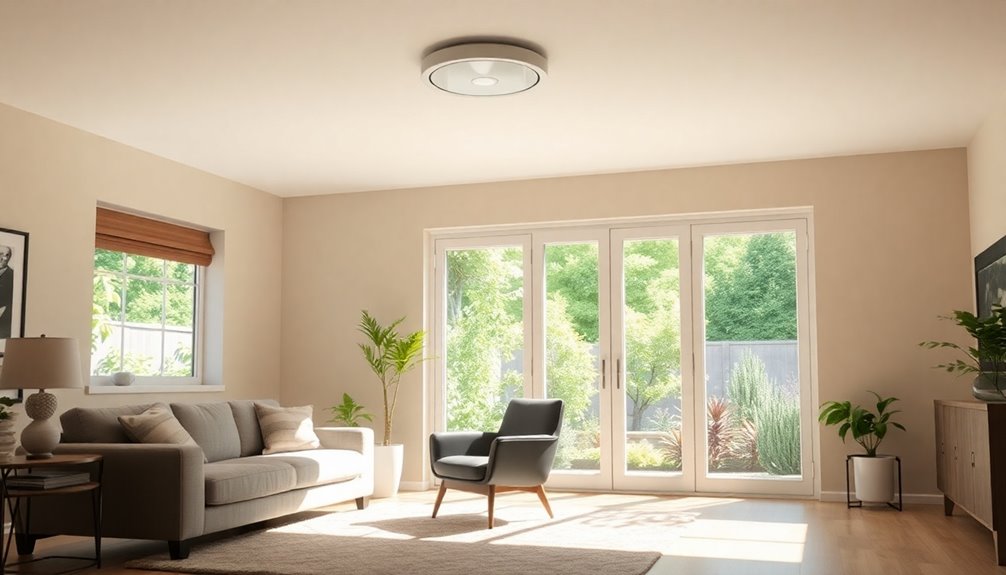
Creating an accessible home involves integrating smart solutions that enhance daily living. One effective upgrade is the installation of efficient, helpful light sensors.
These sensors automatically detect room occupancy, turning lights on or off, which is especially beneficial for those with mobility challenges. By minimizing the need for manual operation, you can make sure to reduce the risk of falls and accidents, addressing common accessibility issues.
Not only do light sensors promote independence for seniors and individuals with disabilities, but they also contribute to energy efficiency by ensuring lights are only used when needed. This simple addition can create a more user-friendly environment, ultimately enhancing comfort and safety for everyone in your household. Additionally, implementing vertical storage solutions can further enhance accessibility by keeping essential items within easy reach.
A Home That Looks Like Home
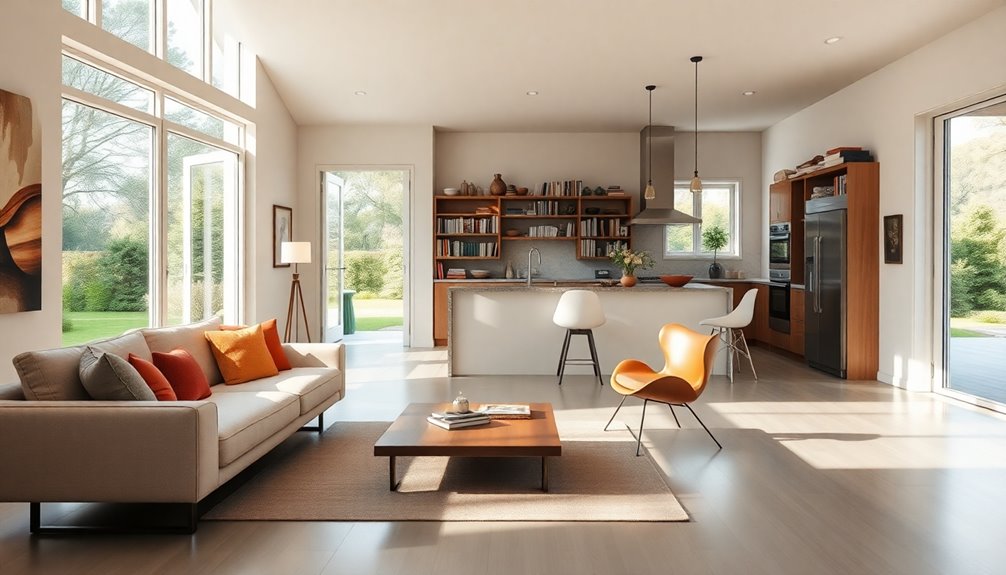
While a home should reflect your personal style, it can also be functional for everyone, regardless of age or ability. Accessible design emphasizes creating spaces that look inviting without an institutional feel.
By incorporating stylish recliners and family-friendly faucets, you enhance your home's aesthetic while ensuring accessibility for seniors and young children. Features like wide doorways and lever handles not only improve usability but also contribute to a modern design.
Thoughtfully chosen textures and finishes can aid navigation for those with vision impairments, creating a cohesive look throughout. This approach allows you to enjoy your space while supporting aging in place, proving that beauty and functionality can coexist seamlessly in your home. Additionally, maintaining a clean environment can reduce allergens and pollutants, further enhancing the comfort and safety of accessible spaces.
Curbless, Doorless Shower

When it comes to enhancing bathroom accessibility, a curbless, doorless shower stands out as a practical and stylish choice. It eliminates barriers, making it easier for anyone using walkers or wheelchairs to enter and exit safely.
Plus, it creates a minimalist aesthetic that seamlessly blends wet and dry areas.
Here are three fantastic features of a curbless, doorless shower:
- Slip-resistant tiles guarantee safety, preventing falls in wet environments.
- Grab bars installed alongside provide added support, boosting confidence while bathing.
- The open design promotes freedom of movement, encouraging independence in personal care routines.
Additionally, using natural materials in the shower design can enhance the overall ambiance, promoting a tranquil environment.
With these elements, your bathroom can be both accessible and visually appealing.
Wheelchair-Accessible Bedroom
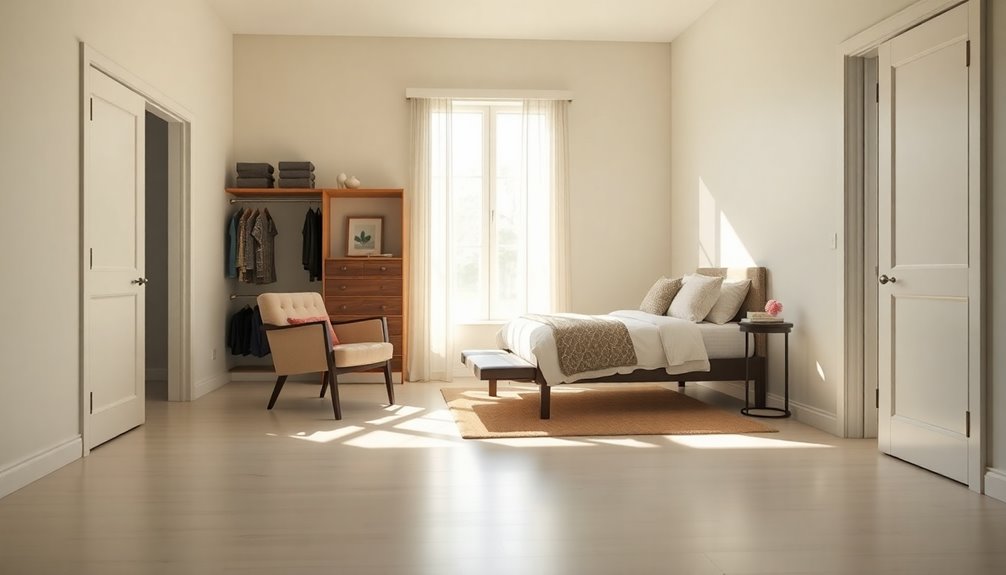
Designing a wheelchair-accessible bedroom is essential for guaranteeing comfort and independence. It's really important to create a space that accommodates people with mobility challenges. Confirm doorways are at least 32 inches wide, ideally 36 inches, for easy access. Allow 5 feet of turning space for maneuverability.
Here's a quick overview of key features:
| Feature | Dimensions | Purpose |
|---|---|---|
| Doorway Width | 32-36 inches | Easy wheelchair access |
| Turning Space | 5 feet | Comfortable movement |
| Bed Height | 20-23 inches | Easy transfer in/out of bed |
| Accessible Storage | Lower shelving | Items within reach |
Selecting furniture wisely helps minimize clutter, making the bedroom a welcoming, functional space.
Family-Friendly Faucet
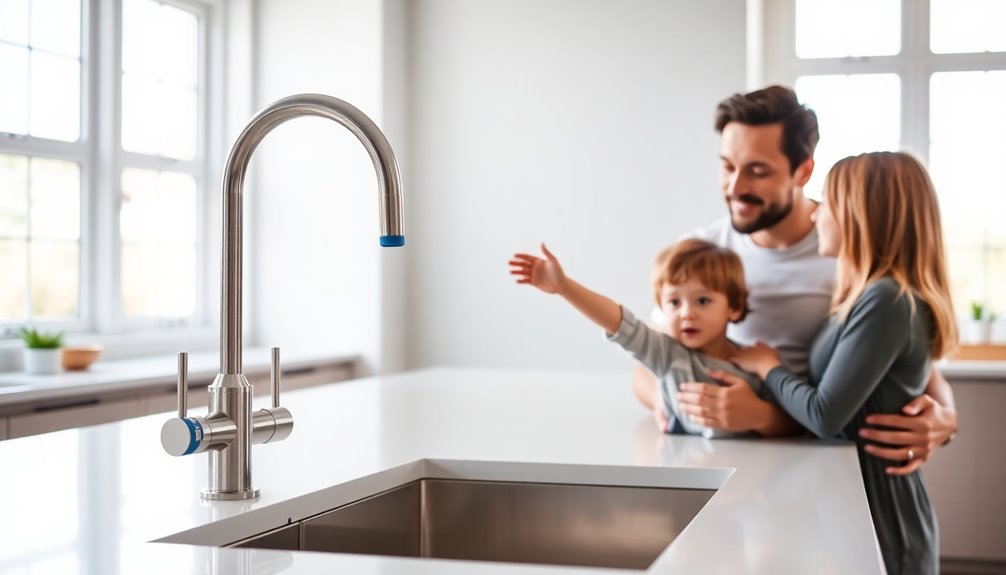
When you choose a family-friendly faucet, you'll appreciate how easy it's to control the water temperature with just one handle.
This design not only simplifies use for kids and seniors but also enhances kitchen accessibility for everyone.
With these features, you can create a safer and more efficient cooking space for all family members. Additionally, maintaining good oral hygiene is crucial for children, and having easy access to water can encourage them to drink more and reduce sugary snacks.
Easy Temperature Control
Having easy temperature control in your home can make a world of difference, especially with family-friendly faucets that cater to all ages.
These faucets are designed to meet diverse needs, making them easy for people of all abilities to use.
Here's how they enhance your space:
- Single Handle Design: Operate the faucet effortlessly, whether you're a child or a senior.
- Anti-Scald Technology: Prevents sudden bursts of hot water, ensuring safety for everyone.
- Ergonomic Features: Minimize wrist strain, making it accessible for individuals with limited mobility.
Additionally, ensuring proper fire safety protocols in your home can further enhance protection for all family members while using appliances like faucets.
Enhanced Kitchen Accessibility
Enhancing kitchen accessibility is essential for creating a welcoming space where everyone can easily contribute to cooking and cleaning. Family-friendly faucets are a key feature, designed with single-handle controls for effortless operation. These faucets not only simplify temperature adjustments but also minimize the risk of scalding—perfect for children and seniors alike. Additionally, integrating smart home devices can further enhance usability and functionality within the kitchen.
| Feature | Benefits | Why It Matters |
|---|---|---|
| Ergonomic Handles | Improved grip | Easier for those with mobility challenges |
| Pull-Down Sprayer | Enhanced usability | Reduces strain when washing dishes |
| One-Hand Operation | Simplifies tasks | Makes cooking and cleaning more accessible |
Beautifully Safe Bathroom

Creating a beautifully safe bathroom involves thoughtful design choices that prioritize accessibility without sacrificing style.
You can achieve a good fit by incorporating features that enhance usability while keeping the space visually appealing.
Here are three essential elements to contemplate:
- Lever handles on doors and drawers for easy operation.
- Colorful or textured handles that provide visual cues for locating fixtures quickly.
- Stylish grab bars that blend seamlessly with other bathroom fixtures.
Wide Doorways

After ensuring your bathroom is beautifully safe, consider how wide doorways can further enhance accessibility in your home.
By installing wide doorways, ideally at least 36 inches wide, you facilitate easier movement for people with disabilities who use wheelchairs, walkers, or other mobility aids. This design choice also reduces the risk of trips and falls by eliminating curbs at entryways, promoting safety for everyone.
Additionally, wide doorways improve traffic flow, making navigation in shared spaces more comfortable. This thoughtful design can empower individuals with limited mobility, allowing them to move freely between rooms.
Plus, implementing wide doorways can boost your home's resale value, appealing to a broader range of potential buyers seeking accessibility features. Furthermore, ensuring legal documentation is updated to reflect any changes in household composition can provide clarity and security for all residents.
Bathroom Bench
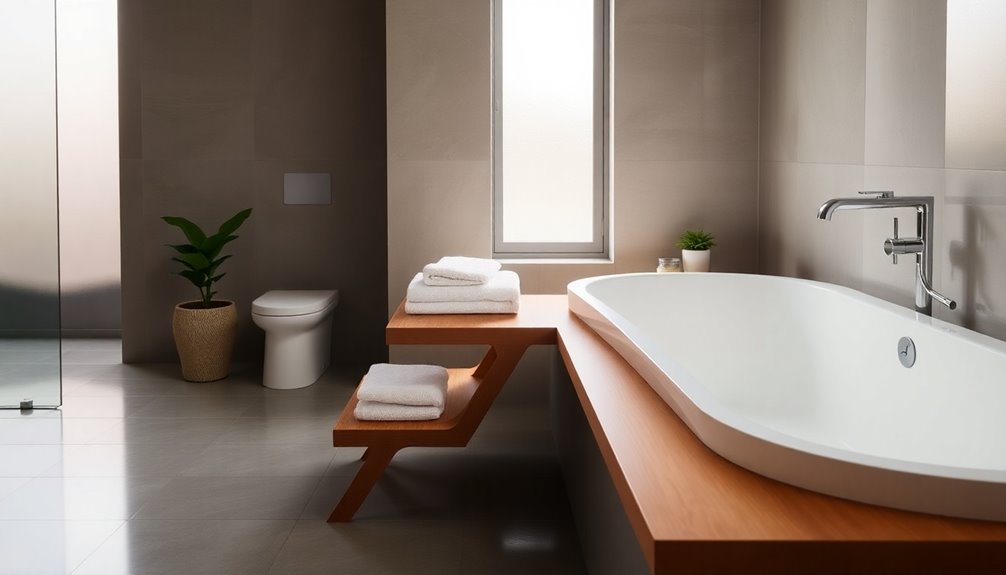
A bathroom bench can be a game-changer for safety and comfort during your daily routines. It provides a stable seating option while you shower or groom, making it much easier to avoid slips and falls.
Here are three benefits of adding a bathroom bench:
- Enhanced Safety: Grab bars near the bench give you support and balance when moving in and out of the shower.
- Adjustable Shower Heads: These allow you to wash from a seated position, accommodating different needs effortlessly.
- Spa-like Atmosphere: A stylish bench adds a touch of luxury, transforming your bathroom into a serene retreat.
With a bathroom bench, your space becomes not only more functional but also really big on comfort! Additionally, incorporating accessibility features can further enhance usability for all individuals in your home.
Slip-Resistant Floor
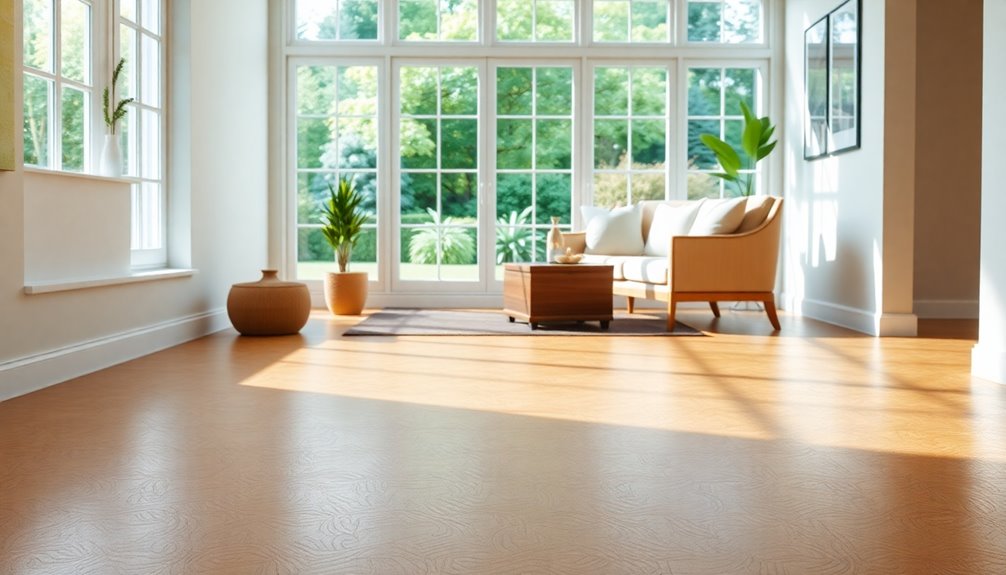
When it comes to enhancing safety in your home, slip-resistant flooring is a must, especially in high-traffic areas. You can choose eco-friendly options like cork or modular carpet tiles that not only prevent slips but also add comfort. These fall prevention strategies not only make your home safer but also improve accessibility for everyone. Additionally, ensuring good air quality with HEPA filtration can further enhance the overall safety and comfort of your living space.
Enhancing Safety Standards
While slip-resistant flooring might seem like a small detail, it plays a crucial role in enhancing safety in your home. By choosing the right flooring, you can greatly reduce the risk of falls, especially in high-traffic areas.
Here are three effective options to take into account:
- Cork Flooring: Offers natural slip resistance and comfort underfoot.
- Modular Carpet Tiles: Replace hazardous mats with a safer, customizable alternative.
- Smaller Format Tiles: Improve grip in bathrooms with increased grout lines enhancing traction.
These choices guarantee that you're not only prioritizing slip resistance but also enhancing safety throughout your space. Additionally, incorporating features like heat pump technology can help maintain a comfortable temperature, further reducing the risk of slips in colder conditions.
With these upgrades, you can create an accessible environment that keeps everyone safe and comfortable.
Eco-Friendly Flooring Options
Choosing slip-resistant flooring not only enhances safety but can also align with environmentally friendly practices. Eco-friendly options, like cork flooring, provide natural slip resistance while being sustainable.
This soft surface underfoot is perfect for high-traffic areas, greatly reducing the risk of falls in your home. If you want a cost-effective solution, consider applying treatments to existing floors for improved slip resistance without a complete replacement.
Additionally, modular carpet tiles are a great alternative to hazardous mats; they're easy to install and allow for quick updates. By carefully selecting flooring materials, you can create a comfortable, aesthetically pleasing, and accessible environment for all ages and abilities.
Prioritizing slip resistance has never been easier or more eco-conscious!
Fall Prevention Strategies
To guarantee a safe living environment, incorporating fall prevention strategies is essential, especially in areas prone to slips and falls.
You can greatly enhance slip resistance in your home by implementing the following:
- Cork Flooring: This eco-friendly option offers softness underfoot and reduces the risk of slips, making it ideal for high-traffic areas.
- Modular Carpet Tiles: These let you easily replace hazardous mats while maintaining safety and comfort, ensuring a secure walking surface.
- Smaller Format Bathroom Tiles: Using proper grout improves grip, especially in wet areas, where accidents are more likely to occur.
Frequently Asked Questions
What Is an Example of a Universal Design Accessibility?
An example of universal design accessibility is a curbless, doorless shower.
You'll find it eliminates barriers, making it easier for individuals using walkers or wheelchairs to access. This design not only enhances independence but also promotes safety by reducing the risk of falls.
When you incorporate such features into your home, you create a more welcoming environment that accommodates everyone, regardless of age or ability, ensuring comfort and functionality for all users.
How Can Universal Design Be Integrated Into Home Design?
You can integrate universal design into your home by ensuring wide doorways for easy movement and incorporating curbless, doorless showers for safer access.
Consider using single-handle faucets in your kitchen to simplify operation for everyone.
Thoughtfully plan furniture heights and layouts to accommodate diverse needs, promoting comfort.
Additionally, smart home features like voice-activated lights can enhance accessibility, making daily tasks more convenient for individuals with mobility or vision impairments.
What Is an Example of a Universal Design in Everyday Life?
Did you know that over 61 million adults in the U.S. live with a disability?
One great example of universal design in everyday life is a curbless, doorless shower. It eliminates barriers, making bathing easier for people of all ages and abilities.
By promoting independence in personal care routines, you'll enhance not only your own experience but also that of family members and guests.
This thoughtful design truly caters to everyone's needs.
What Are the 7 Principles of Universal Design With Examples?
The seven principles of universal design include equitable use, flexibility in use, simple and intuitive use, perceptible information, tolerance for error, low physical effort, and size and space for approach and use.
For instance, you might appreciate a single-handle faucet (equitable use) or an adjustable shower head (flexibility).
Curbless showers simplify access (simple use), while slip-resistant flooring minimizes slips (tolerance for error), ensuring a safer, more enjoyable environment for everyone.
Conclusion
By embracing these universal design ideas, you're not just creating an accessible home; you're building a space that welcomes everyone, regardless of their abilities. Imagine a world where every home feels like a cozy café, inviting and inclusive. These thoughtful changes make life easier and enrich your daily experiences. So go ahead, transform your space—after all, who wouldn't want to live in a home that feels like a warm hug? Your future self will thank you!
